- Author: Ed Perry
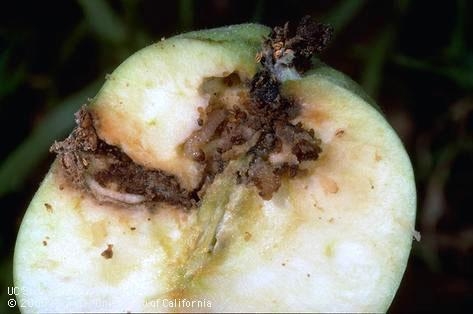
If you decide to fight them, now is a good time to plan your strategy since the most critical time to protect your fruit from the pest is spring. Warm spring weather causes most of the first generation moths to emerge within a few weeks. The moths may take 6 weeks or more to emerge during a cool spring. Once they have emerged, the codling moths are still affected by temperature. They do not lay eggs or mate when it's below 62°F at sunset or fly when it's 55°F.
The moths emerge from pupae in early spring about the time when fruit trees are in full bloom. Each moth lays 50 to 75 eggs on fruit, twigs, or leaves. Eggs hatch into larvae which tunnel into the young fruit. Inside the fruit, the larvae feed for several weeks, then tunnel to the fruit's surface and search for protected sites such as under tree bark, in branch wounds, weeds, grass or other litter. The larvae changes first to a pupa, then to an adult and repeats the cycle.
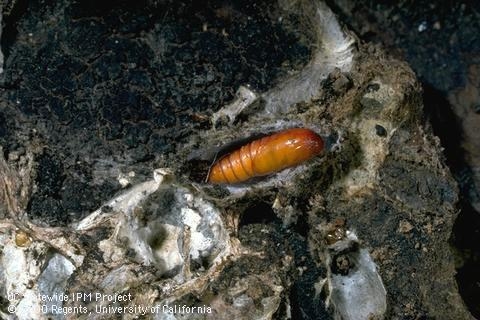
You can also trap many larvae under bands. Take a 6-inch wide strip or burlap or corrugated cardboard, wrap it around the trunk several times, then fasten it in place with a loop of wire or twine. If you use corrugated cardboard, the exposed flutes (ridges) must be at least 3/16 of an inch wide and face toward the tree; otherwise, the larvae won't form cocoons in them. Place a band on each tree no later than mind-May. During warm weather remove the band once a week, and during cool weather once every two weeks. Destroy all the larvae and pupae under the band, and then put the band back on the tree. Keep doing this until you've harvested all the fruit.

Insecticidal sprays are usually the most effective means of controlling codling moths. Sprays give best control when you apply them just after a large number of larvae hatch, but before they burrow into the fruit. These times are several days after a period of peak moth flight and vary according to the year and location.
When using any chemical, carefully follow dilution rates and other directions given on the container label. Do not spray within the number of days before harvest indicated on the label. You can read more details about the life cycle of this pest and management, including chemical controls in the UC IPM Pest Notes: Codling Moth.
Ed Perry is the emeritus Environmental Horticultural Advisor for University of California Cooperative Extension (UCCE) in Stanislaus County where he worked for over 30 years.
- Author: Anne E Schellman
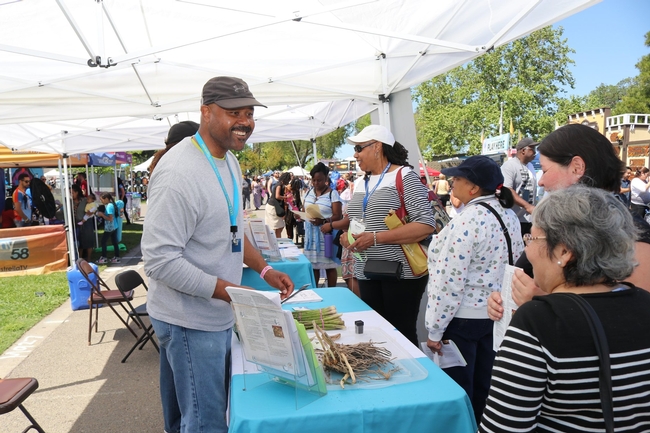
The UCCE Stanislaus County Master Gardener Demonstration Garden and Outdoor Classroom!
What would this look like? We envision an accessible garden everyone can visit and explore.
Garden Days
Each week, volunteers will be available for a few hours so you can stop and ask your gardening questions. Once a month, they will be around on the weekend.
Our demonstration garden will also be a place to hold fun events like tomato tastings, kids' gardening activities, health fairs, and Stanislaus County sponsored events.
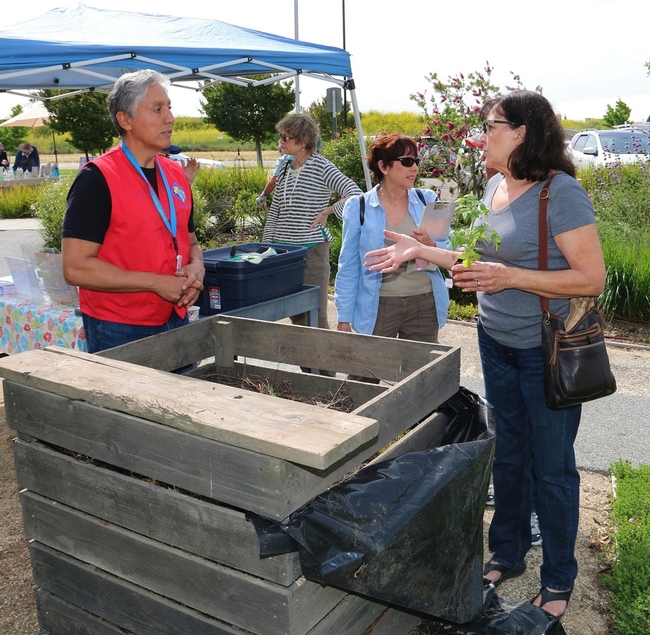
Demonstration Gardens
Imagine meandering paths through colorful and inviting gardens that showcase plants and gardening methods, including a water-wise garden, California native pollinator garden, herb and vegetable garden, fruit orchard, and children's sensory garden.
Outdoor Classroom Amphitheater
Sign up for a class and sit outside and listen to a Master Gardener led class on how to install drip irrigation, prune fruit trees, or compost. Then, “get your hands dirty,” by practicing installing drip irrigation, pruning a fruit tree, or layering a compost pile.
How Can You Help?
Some generous local sponsors have offered to help with in-kind donations of irrigation materials. We need your help in raising funds to help with lawn removal, plants, path material, mulch, and other items. If you know an Eagle Scout or Girl Scout Troupe that needs a project, we are happy to speak to them about benches and gardening art as well!
Donate Now
Please make your gift for #BigDigDay, on June 5, 2020 now to help us get our garden started! 
Using the drop-down menu, select “Stanislaus County.” Your donation will go directly to help us fund the garden. Stay tuned for future posts telling you when we break ground and start work!
If you know of an organization willing to donate materials, that's great too! Please contact us at ucmgstanislaus@ucanr.edu
Photos in this post to help us imagine our new garden are from our sister program, the UCCE San Joaquin Master Gardener Program, located in Stockton.
- Author: Rho Yare

The tomato, commonly called a vegetable, is a fruit botanically, and hard to believe but the tomato was the center of a U.S. Supreme Court decision, Nix vs. Hedden. Now, this is a fascinating bit of historical trivia. In the 1800's there was a tariff that put a tax on imported vegetables. Well, a business owner in New York City named John Nix wasn't too happy about this. He sued Edward Hedden, the “Collector of the Port of NYC” (tax collector). Mr. Nix declared that since tomatoes are a fruit, he was owed back taxes.
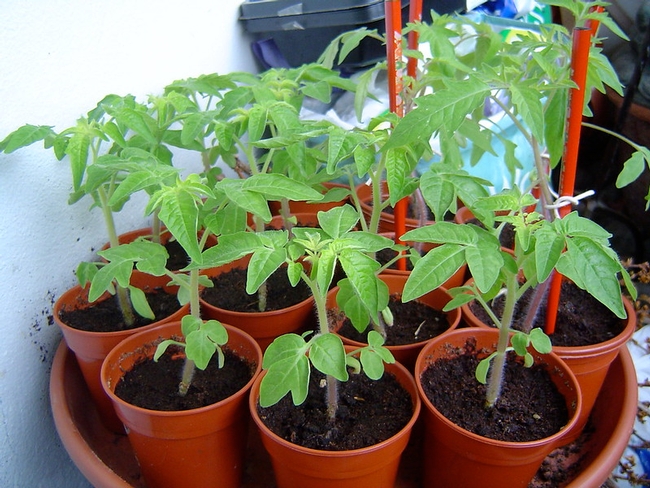
In Stanislaus County from early July and for months afterward, you'll see tomato truck gondolas on the road 24 hours a day filled with red, ripe tomatoes rushing to processors. We have perfect tomato growing conditions.
A tomato is not too picky. That's another reason it's so popular to grow. All that is required is full sun, an area (container or ground) with some soil, a support of some type, some water, some fertilizer, and a little love.
If you are a container/patio gardener, look on the label or tag for the term “determinate,” as these plants work best in containers. Also, anything named patio or pixie. Cherry tomato varieties are indeterminate but work great in a container. Use at least a 5-gallon bucket-sized container (with holes in the bottom). Your plant will need some support, but not as much as the indeterminate varieties.

To ensure your plant is planted correctly, make your hole as wide and deep as the root ball of the plant. This is the area of soil and roots that you remove from the original container. The cool thing about tomatoes is you can plant them as deep as you need to if they are leggy.
To plant, carefully remove the root ball, and gently loosen the root mass and with gardening clippers or scissors remove lower branches. You are going to plant about 1/3 of the green plant below the soil. Gently pat the soil around the plant . Don't forget to place your support around or next to the plant now so you don't forget. Water gently and stand back and admire your gardening expertise. And imagine those delicious tomatoes gracing your salad, sandwich, or as I like to do, eat them out of my hand with a few napkins to catch the juice.
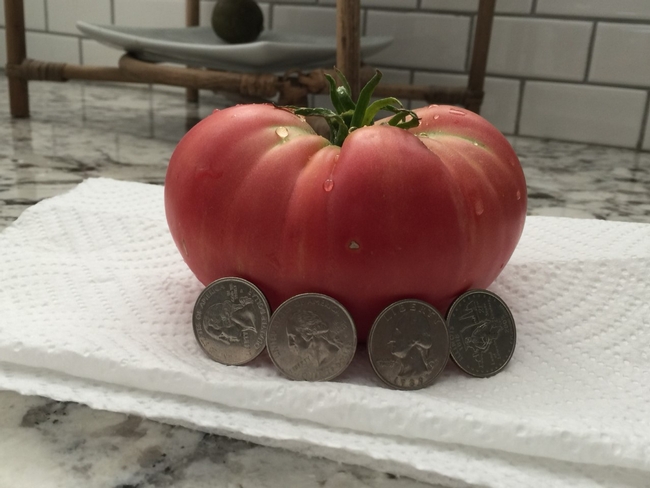
I hope you plant at least one tomato plant this season and send us pictures of your successes to ucmgstanislaus@ucanr.edu. Happy gardening and enjoy those dirty hands.
Be sure to join Rho on Wednesday, April 15 at 6 p.m. for Spring Container Vegetable Gardening. Sign up on our class website at https://ucanr.edu/sites/stancountymg/Classes/
- Author: Ed Perry
For gardeners the coming of winter means, among many other things, the beginning of the bare root planting season. Local nurseries will soon receive good supplies of bare root fruit and ornamental trees, roses, grapes, berries, and vegetables such as asparagus and rhubarb. Unlike container plants, bare root plants are dug from the field when dormant and separated from the soil. This allows the nursery grower to ship plants at a lower cost and means a good saving for the buyer.
Since all the soil has been removed from the roots, take care to prevent them from drying out while you transport the tree or dig the planting hole. Never allow the plant roots to be exposed to sun and wind for more than just a few minutes. You can protect the roots for a few hours by placing them in a moist plastic bag or by covering them with wet newspaper or cloth. It's best to plant and water your bare root trees right away. If you need to delay planting for a day or more, you should “heel in” the plants. “Heeling in” is a method of protecting plant roots by placing the plants into a hole or shallow trench and covering the roots with moist soil, sand or sawdust.

You should consider trees, shrubs and other perennial plants to be long term investments. It's therefore worth the effort to pick the proper place for the plant. Fruit trees especially need full sun to produce properly, as well as room to grow. Most standard fruit trees can be planted 10 to 15 feet apart, or much closer if you are willing to spend time doing heavy pruning and careful training each year. Semi-dwarf fruit trees are good choices for a garden with limited space. It is not a good idea to plant a fruit tree in a lawn area, as the lawn's water requirements are not compatible with those of the tree. Fruit trees growing in lawns often grow poorly or are killed by shallow, frequent lawn irrigation.
Fruit trees prefer well drained soils at least 3 or 4 feet deep but will grow in shallower soils if you water carefully. Plant your tree when the soil is moist enough to dig easily. Do not plant in wet, sticky soil. The planting hole should be 2 to 3 times wider than the root spread, but only deep enough to plant the tree at the same level as it grew in the nursery. A tree planted in a deep hole will settle too much after watering. When this happens the tree is often attacked by a soil borne fungus disease where the soil contacts the trunk.
Before you plant the tree, carefully cut off broken or badly damaged roots with sharp pruning shears. Do not prune the roots to fit the hole. If necessary, put soil in the bottom of the hole so that the tree is slightly higher than the soil line. This will allow the tree to settle slightly without becoming buried. Using the same soil that came out of the hole, carefully cover the roots completely, then water thoroughly to settle the soil around the roots. You may want to complete the planting job by placing a mulch on the ground around the tree to help control weeds and conserve moisture.
For more information on care of your newly planted bare root fruit trees, berries, grapes, and roses, visit The California Backyard Orchard.
- Author: Ed Perry
Splitting of navel oranges is a disorder that shows up every few years in the Northern San Joaquin Valley. It's difficult to predict the problem, and once you see oranges beginning to split, it's too late to do anything about it. However, it may be useful to talk about why splitting may occur, and what you can do to help lessen the problem.
While you may not notice it until the fruit begins to ripen, splitting in navel oranges begins in green fruit. The split usually starts at the stylar or navel end of the fruit, the weakest point in the rind. The split may be short and shallow, or it may be deep and wide, exposing the segments. Splitting is most serious in navel oranges, but it may occur in Valencia oranges too.
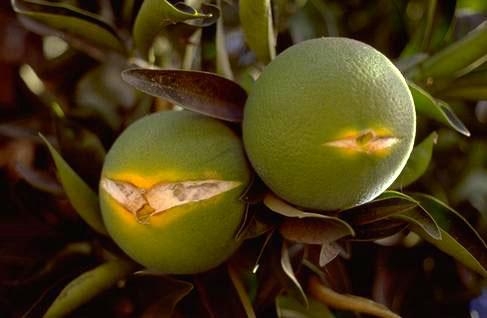
It is not well understood just what causes splitting, but it's thought to be caused mainly by a combination of environmental conditions. Some studies show that changes in climate such as temperature and relative humidity may have more effect on splitting than anything else. A couple of my citrus reference books indicate that splitting is caused by hot, dry weather, alternating with humid, cloudy weather. Allowing the soil to dry out too much between irrigations is believed to result in increased splitting. However, other research and observations in orange groves have shown that irrigation, fertilizers and other cultural practices make no difference in the amount of splitting that occurs in any given year.
It is obvious that you cannot control all of the factors that cause splitting, since weather conditions are involved. However, you may be able to minimize the problem by making sure that your orange tree is well watered. Remember that orange trees (as well as other citrus) are not drought tolerant and need a constant supply of moisture in the root zone. If your soil is sandy you may need to water a fully-grown orange tree every ten to fourteen days during the summertime. In clay soils, the watering schedule may be every fourteen to twenty-one days. You should continue to water your trees periodically in fall, at least until rain begins.
Ed Perry is the emeritus Environmental Horticultural Advisor for University of California Cooperative Extension (UCCE) in Stanislaus County where he worked for over 30 years.

